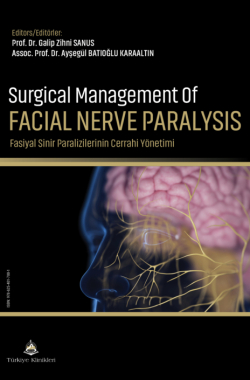Evaluation of Facial Nerve Paralysis and Differential Diagnosis
Nurten UZUN ADATEPEa, Ceren ALİŞb
aİstanbul University-Cerrahpaşa, Cerrahpaşa Faculty of Medicine, Department of Neurology, İstanbul, Türkiye
bİstinye State Hospital, Clinic of Neurology, İstanbul, Türkiye
Uzun Adatepe N, Aliş C. Evaluation of facial nerve paralysis and differential diagnosis. In: Sanus GZ, Batıoğlu Karaaltın A, eds. Surgical Management of Facial Nerve Paralysis. 1st ed. Ankara: Türkiye Klinikleri; 2022. p.23-9.
ABSTRACT
In daily clinical practice, one of the ways to solve a problem is by analogy with another one experienced before. Although it could be concluded in this way quickly, the risk of misdiagnosis is high. In the scientific analysis, which is the other method, the problem is investigated based on of the underlying defect of structure and function step by step. Solving a problem could be achieved with the information of anatomy, physiology, and physiopathology in clinical practice. The data we have are the symptoms and signs obtained from the history of the patient and physical examination. When the patient is encountered, some questions come to mind, such as ‘Is there a lesion that affects the nervous system?’, ‘Where is the lesion in the nervous system?’ and ‘What is the nature of the lesion?’ from the perspective of neurology. After the anamnesis and neurological examination, the stage of detecting the etiology starts via examining the size, morphology, distribution, and level of the lesion in the nervous system, whether the topography of the lesion is focal, widespread, or multifocal. At this stage, whether the onset of the disease is acute, subacute, chronic, or recurrent and the prognosis of the disease are questioned. When an anatomopathological decision is concluded, the diagnosis is confirmed with other laboratory tests, after other diseases in the differential diagnosis are excluded. The patient’s approval is obtained at each step by explaining the way to be followed at each stage. In this article, the evaluation of a patient presenting with peripheral facial paralysis will be reviewed.
Keywords: Facial paralysis; peripheral facial paralysis; differential diagnosis
Kaynak Göster
Referanslar
- Haines DE, Mihailoff GA. A synopsis of cranial nerves of the brainstem.In: Haines DE, Mihailoff GA, eds. Fundamental Neuroscience for Basicand Clinical Applications. 5th ed. Philadelphia: Elsevier; 2018. p.195-211. [Crossref]
- Kızıltan G, Ertan S. Kranial sinirler. Apaydın H, editör. Nöroloji DersKitabı. yayın No: 4748. 1. Baskı. İstanbul: İstanbul Üniversitesi; 1995.p.35-80.
- Şirin NG, Akman-Demir G, Zarko Bahar S, Aktin E. Sinir sisteminin kısaanatomisi. Öge AE, Baykan B, Bilgiç B, editörler. Nöroloji e-Ders Kitabı(online); 2020.
- Lorch M, Teach SJ. Facial nerve palsy: etiology and approach to diagnosis and treatment. Pediatr Emerg Care. 2010;26(10):763-9; quiz 70-3. [Crossref] [PubMed]
- Hızal E, Özlüoğlu LN. [Etiology and assessment]. Turkiye Klinikleri JE.N.T-Special Topics. 2016;9(2):12-22.
- House JW, Brackmann DE. Facial nerve grading system. otolaryngolHead Neck Surg. 1985;93(2):146-7. [Crossref] [PubMed]
- Kızıltan M.E, Uygunoğlu U. Fasiyal sinir tutulumları. Emre M, editör.Nöroloji Temel Kitabı. 1. Baskı. Ankara: Güneş Tıp Kitabevleri; 2013.p.451-7.
- owusu JA, Stewart CM, Boahene K. Facial nerve paralysis. Med ClinNorth Am. 2018;102(6):1135-43. [Crossref] [PubMed]
- Spencer Cr, Irving rM. Causes and management of facial nerve palsy.Br J Hosp Med (Lond). 2016;77(12):686-91. [Crossref] [PubMed]
- Gilden DH. Clinical practice. Bell's palsy. N Engl J Med.2004;351(13):1323-31. [Crossref] [PubMed]
- Heckmann JG, Urban PP, Pitz S, Guntinas-Lichius o, Gágyor I. The diagnosis and treatment of idiopathic facial paresis (Bell's palsy). DtschArztebl Int. 2019;116(41):692-702. [Crossref] [PubMed] [PMC]
- Bagnato F, Stern BJ. Neurosarcoidosis: diagnosis, therapy and biomarkers. Expert rev Neurother. 2015;15(5):533-48. [Crossref] [PubMed]
- reich SG. Bell's palsy. Continuum (Minneap Minn). 2017;23(2, SelectedTopics in outpatient Neurology):447-66. [Crossref] [PubMed]
- Kirazlı T, Kaya İ. [Bell palsy]. Turkiye Klinikleri J E.N.T.-Special Topics.2016;9(2):45-50.
- Keane Jr. Bilateral seventh nerve palsy: analysis of 43 cases and reviewof the literature. Neurology. 1994;44(7):1198-202. [Crossref] [PubMed]
- Halperin JJ. Facial nerve palsy associated with lyme disease. MuscleNerve. 2003;28(4):516-7. [Crossref] [PubMed]
- Serrano P, Hernández N, Arroyo JA, de Llobet JM, Domingo P. BilateralBell palsy and acute HIV type 1 infection: report of 2 cases and review.Clin Infect Dis. 2007;44(6):e57-61. Epub 2007 Feb8. [Crossref] [PubMed]
- riancho J, Delgado-Alvarado M, Valero C, Echevarría S, Fariñas MC.Clinical spectrum of peripheral facial paralysis in HIV-infected patientsaccording to HIV status. Int J STD AIDS. 2013;24(1):39-41. [Crossref] [PubMed]
- Halperin JJ. Nervous system Lyme disease. Handb Clin Neurol.2014;121:1473-83. [Crossref] [PubMed]
- Portelinha J, Passarinho MP, Costa JM. Neuro-ophthalmological approach to facial nerve palsy. Saudi J ophthalmol. 2015;29(1):39-47. [Crossref] [PubMed] [PMC]
- Asma A, Marina MB, Mazita A, Fadzilah I, Mazlina S, Saim L. Iatrogenicfacial nerve palsy: lessons to learn. Singapore Med J. 2009;50(12):1154-7.
- Wakerley Br, yuki N. Isolated facial diplegia in Guillain-Barré syndrome:bifacial weakness with paresthesias. Muscle Nerve. 2015;52(6):927-32. [Crossref] [PubMed]
- Nigrovic LE, Thompson AD, Fine AM, Kimia A. Clinical predictors of Lymedisease among children with a peripheral facial palsy at an emergencydepartment in a Lyme disease-endemic area. Pediatrics.2008;122(5):e1080-5. [Crossref] [PubMed]
- Jung J, Park DC, Jung Sy, Park MJ, Kim SH, yeo SG. Bilateral facialpalsy. Acta otolaryngol. 2019;139(10):934-8. [Crossref] [PubMed]
- Mancini P, Bottaro V, Capitani F, De Soccio G, Prosperini L, restaino P,et al. recurrent Bell's palsy: outcomes and correlation with clinical comorbidities. Acta otorhinolaryngol Ital. 2019;39(5):316-21. [Crossref] [PubMed] [PMC]
- Dhawan Sr, Saini AG, Singhi PD. Management strategies of melkersson-rosenthal syndrome: a review. Int J Gen Med. 2020;13:61-5. [Crossref] [PubMed] [PMC]
- Falco NA, Eriksson E. Facial nerve palsy in the newborn: incidence andoutcome. Plast reconstr Surg. 1990;85(1):1-4. [Crossref] [PubMed]
- Picciolini o, Porro M, Cattaneo E, Castelletti S, Masera G, Mosca F, etal. Moebius syndrome: clinical features, diagnosis, management andearly intervention. Ital J Pediatr. 2016;42(1):56. [Crossref] [PubMed] [PMC]
- Gillman GS, Schaitkin BM, May M, Klein Sr. Bell's palsy in pregnancy:a study of recovery outcomes. otolaryngol Head Neck Surg.2002;126(1):26-30. [Crossref] [PubMed]

